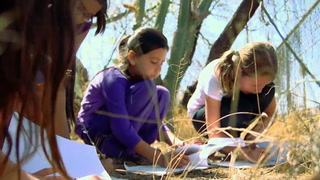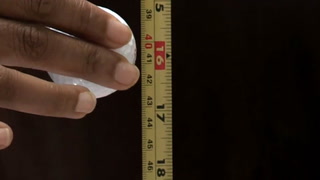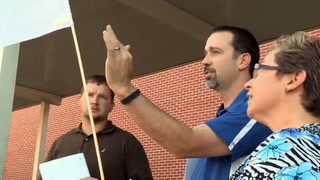NGSS: Disciplinary Core Ideas Transcript
Speaker 1: The goal of instruction is for students to engage in making sense of the world. The
disciplinary core ideas are the tools they use to make sense of the phenomena.
Speaker 2: And I want you to think about how instruction will get students to engage more deeply in using the core ideas.
Speaker 1: The disciplinary core ideas are the content that can be used to construct explanations, and they can be used as a form of evidence to support arguments. And they use them in the context of practices and [?] getting concepts. This idea of three-dimensional thinking really is well-structured in the framework in the next generation science standards. And it helps guide what students will be doing in the classroom.
Speaker 2: We're going to focus on the intersection of three dimensions, but the feature is really disciplinary core ideas.
Speaker 1: The way they're used in the standards is distinguished from historically, when we had students learning the content and then simply being able to tell us the content, these disciplinary core ideas are the things that students use.
Speaker 3: I think the purpose of kind of current instruction is to get students to remember very specific facts about the particular content areas, but I think the new approach is that it's a progression from kindergarten on, and that they're slowly but surely building on these ideas. And I feel like with the way that the core ideas are presented now, it's much easier for teachers to see that progression, that it makes a bit more sense to them.
Speaker 1: Disciplinary core ideas can be applied to multiple phenomena. There's one that talks about how energies involve when matter changes. Well, that is true for when an ice cube melts. It's true when sunlight is used as the energy source for photosynthesis in a leaf. It has that kind of utility across many many phenomenon, and this framework describes that.
Speaker 2: So we're going to engage you in an investigation.
Speaker 4: So the supercontinent began to break apart.
Speaker 1: We had the opportunity to work with teachers, engaging them in core ideas, and help them to understand and make connections to what they're currently doing and move them forward in their instruction.
Speaker 5: Most mountain ranges are found near plate boundaries. How did the Rocky Mountains end up 2,000 miles from the coast? Do you ever wonder about that?
Speaker 3: We completed a performance where we needed to do some research on how the Rocky Mountains were formed and what made them unusual.
Speaker 5: I want you to think about the core ideas from the standards, specifically the Earth systems ideas related to plate tectonics. I want you to think about the theories that support your explanations and how they play a role in evidence.
Speaker 6: [?] time then it results in the creation of the mountain plate is progressing outwards.
Speaker 2: They have to use disciplinary core ideas about forces, about motion, and about plate tectonics. So that core idea becomes very very important to making sense of a phenomenon that they've never even heard about before.
Speaker 7: There was an older mountain range 300 million years ago that eroded and it was reformed into the Rocky Mountains.
Speaker 3: So it was part of an old mountain range. How did that mountain range form?
Speaker 7: I don't know.
Speaker 3: I think it's so important for the students to be able to have this broad understandings of how their world works, and so as they come across a new phenomenon, they're going to be able to make some connections to past experiences and prior knowledge that's going to give them a better understanding of whatever's presented to them that's new.
These two prints here, they're going to represent the North American plate and they're laying down. And on top of that plate are layers of sediment, shallow angle of the Pacific plate coming underneath, and so that uplifted the granite. And as that happened, some of the sediment came off, and then eventually, through erosion, all of this sediment came off and revealed the granite Rocky Mountains.
Speaker 2: Why did the sediment wait until she uplifted to run off?
Speaker 8: Gravity.
Speaker 2: Gravity. And by the way, this idea of gravity is a core idea.
Speaker 1: They did not gather information that told them exactly why. Without an understanding of a number of core ideas, they could not have come up with a performance to describe an explanation for it or develop a model to communicate why.
Speaker 5: These plates, what happened to this plate?
Speaker 9: It melted.
Speaker 5: Is there a core idea that helps me make sense of that?
Speaker 3: If we can focus in on something very specific to help teach a much broader, bigger idea, that it actually helps the students be able to do that application to new scenarios, new situations, by letting them really focus in and drill down on one specific example.
Speaker 2: This idea that we have talked about today, how do you see something that you do being modeled like we had modeled today become part of your instructions?
Speaker 3: Kind of a big shift for me is that it's more about teaching the bigger picture so that students can apply that more generalized core idea to lots of different examples and not just one specific thing that they need to remember.












9 Comments
Crystal Riverso Jul 13, 2023 12:04pm
Disciplinary core ideas include the essential knowledge necessary to apply content to situations. I think a challenge for teachers is making sure students have the fundamental knowledge in order to see "the big picture" rather than making generalizations. The scaffolding at each grade level of the DCI is critical in the ability of students to truly apply their knowledge to new ideas and other disciplines.
Krystal Melendez Aug 27, 2021 1:29pm
1. The Disciplinary Core Ideas are the science content topics. This includes Earth and Space science, Engineering and Technology, Physical Science, and Life Science.
2. The Disciplinary Core Ideas are used differently than content has been in the past because before, the conent was just taught to students and they were only required to recite it back to us. Through NGSS, students are able to explore, interact and even discover the content information for themselves.
3. This new content is requiring a progress where the things students learn build off of what they have learned in previous grade levels. The students are learning more each year and the content is building off of what information they have from previous courses.
Karen Hobbs Jul 20, 2020 2:56pm
Finally, a good example of teaching within the NGSS. I find my students would rather have facts to memorize than to have to use their minds. This will be challenging and rewarding in the classroom!
twjuana TJ Williams Jun 16, 2020 4:15pm
this DCI reminds me of past, present , future with the unknown that peaks the discovery of a students mind and unlocks the minds of those who had one way of thinking. this idea engages all students at all levels and it help everyone see that the simple planting of a seed and watering it causes firm trees with unlimited branches, I love it!!!
Kathleen Mockus Mar 15, 2017 1:42pm